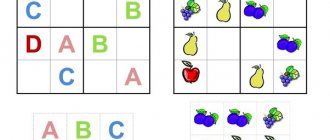How does a child’s communication change throughout preschool age?
The need for communication is inherent in human nature. But this need has many nuances. At different age stages, communication performs its actual functions. The nature and motives of communication change even at such a short stage as preschool childhood.
Firstly, the circle of people with whom the child interacts is gradually expanding. First of all, these are adults who explain, help, and protect everything. But then the preschooler’s interest in communicating with children like himself becomes more active.
Secondly, the subject matter of communication changes. Communication based on practical actions is being replaced by mental communication. If a 3-4 year old child reaches out to his interlocutor to show what a beautiful dress a doll has or talk about a new car, then a five year old child can spend hours asking his “Why?”, simply walking next to his mother.
No improvised objects or toys are needed to ask where the sun sets, what the rainbow is made of, or why the chicken doesn’t fly. And all this interests children so much.
The progress of communication in preschool age continues further, introducing new motives for the need to communicate with adults or peers. Having bombarded their parents with questions about natural phenomena and learned something for themselves, children strive to share their knowledge with their peers. And adults are addressed with the next batch of questions - now about people’s relationships, professions, hobbies and other human subtleties.
Communication is the best opportunity to get to know the surrounding reality and yourself. This is one type of activity, which is why it is called a communicative activity. Preschoolers are involved in this activity. They are guided by different motives. Forms of communication in preschool age acquire an extra-situational character, since the development of cognitive processes and speech allows the child to reason abstractly, and not just about what he sees and hears at a particular moment.
Why does a child need contact with peers?
As the baby grows up, he needs to communicate with other children of the same age or a little older.
This communication is significantly different from that which is accepted within the family circle. After four years, a child will be much more interested in talking with his peers than with his parents or relatives. When playing with children, the baby will be able to fully realize his fantasies and will be able to behave at ease and freely. And this behavior significantly affects speech. By contacting peers, the child will be able to clearly express his emotions. When communicating with parents, the baby behaves calmly, even passively. And when he begins to interact with other children, he may suddenly laugh, express his feelings with facial expressions, bright intonation, or even squeal. When communicating with peers, a child uses up to 10 facial and speech manifestations, while in a conversation with an adult partner - only half. It is those feelings that are expressed in contact with children that help the child acquire relaxedness, freedom and ease between peers.
Basic conditions for the development of communication in preschool age
Close people play a primary role in a child’s life, and the child’s involvement in communication depends on them. Unlike older children, any activity of preschoolers is directed by adults. The corresponding features of communication between preschool children are emerging:
- An adult gradually immerses the child in the knowledge and skills developed by many generations of humanity, and without which life is unthinkable.
- The child perceives adults as a model - how to behave, what feelings and qualities to show in various situations.
- When communicating with adults, the preschooler receives feedback in the form of support and praise.
- Communication with peers provides an opportunity for a child to get to know himself and realize that he is one of the same children.
Motives for communication among preschoolers
Let's find out what motives drive preschoolers when they initiate communication with an adult or peer. A 3-year-old child hands his dad parts of a construction set - this is already an invitation to interact. The 4-year-old “why” besieges his parents with questions about what and how. A 5-year-old preschooler sits his grandmother in a chair and declares that he will treat her. A 6-7 year old child declares that he will go play with Mishka, but he is not interested in playing with Vladik.
In any of these cases, a leading motive appears. , cognitive motives predominate . Children understand that adults can and know a lot, therefore, in addition to emotional attraction to adults, they are driven by cognitive interest.
In middle preschool age, children need play partners. They are attracted to story-based games that simulate everyday life.
And since the most efficient play partner is an adult, children love to involve the role of mothers, grandmothers and, less often, the male part of the family in playing the role. Let gaming activities take place, but business motives of communication predominate at this age.
Older preschoolers actively communicate with both adults and peers. They become selective in relation to their peers. They make friends with whom they are ready to play “mother-daughter”, football and any other game. But a category of children with whom they do not intend to communicate is also identified. And if you play in a team game, then on different teams. Personal motives come to the fore at this age stage .
6-year-old children also continue to approach adults with questions or a desire to hear evaluation and praise. Along with knowledge of the world, they are now often interested in issues of a moral nature. The motives for communication between preschool children and adults in such cases can also be attributed to personal ones.
Development of communication skills in preschool children
The communication need is special. It develops as a need to know oneself and other people. To satisfy this need, at least primary communication skills are important. What communication skills can we talk about at the age of 3-5 years?..
To guide your child in developing successful interactions, pay attention to how your child expresses himself when trying to communicate with similar kids. Communication among younger preschoolers is characterized by:
- Attention to a peer as someone “like myself.”
- Emotional perception of interaction with a peer.
- The desire to show oneself to one’s peers: what I can do, how I do it.
- Sensitivity and receptivity to how your little communication partner treats you.
All of the above components are important. When observing a child, it is easy for adults to notice what is present in abundance and what manifestations are completely absent. For example, if a preschooler is just demonstrating his achievements, you need to intervene and suggest: “Let’s see how a girl/boy can do...”, “You showed off your excavator, and now your friend wants to demonstrate how his cars drive.”
It is useful to regulate the emotional background of communication between preschoolers. For children who are frowning, their mood will be disturbed. Changes in emotions are facilitated by surprise. Figure out how to surprise the kids (by building an unusual tower, demonstrating the unobvious advantages of a familiar toy, etc.), and you will see how their mood will change positively and communication will begin.
If you instill a culture of interaction from early childhood, over time, younger preschoolers intuitively demonstrate such an important quality - paying attention to their communication partner. This is an opportunity to develop the child's communication skills.
Communication among older preschoolers is more multifaceted. After 5 years, children spend significant time with peers. They are connected by various activities that require communication.
This is a role-playing game, creativity, and productive activity. Interaction with others often takes the form of cooperation.
How successful the cooperation will be depends on each participant. In older preschool age, the development of communication skills is closely intertwined with the formation of moral qualities. Goodwill and attention to others, affability and friendliness, willingness to help each other and the ability to give in are qualities without which interpersonal relationships cannot be successful.
Communication between teacher and children
The professional activity of a teacher without pedagogical communication is impossible. Communication between a teacher and children is a system of interaction with the aim of providing educational influence, as well as the formation of a child’s self-esteem and appropriate relationships, and the creation of a favorable microclimate for mental development. The teacher should strive to make pedagogical communication with children as effective as possible, which will contribute to the mental development of children. To achieve this, the teacher should know what his pupils expect from communication, and also take into account the changing needs throughout childhood.
The teacher’s communication with children prepares for the emergence of newer, more complex types of activities. The content and form of the teacher's pedagogical communication are determined by specific tasks that are solved in the process of directing the activities of children.
The effectiveness of pedagogical communication largely depends on the teacher’s ability to take into account the age and individual characteristics of children. The teacher chooses forms of influence to communicate with children of different temperaments and ages. The teacher often expresses special warmth towards the little ones, and also uses affectionate forms of address that children are accustomed to hearing in the family. The teacher expresses interest and sensitivity in his work with older children. However, in this case, for the optimal nature of the relationship, it is necessary to be able to joke and, if necessary, speak strictly and seriously.
The content of the teacher’s communication changes taking into account the children’s behavior, and their inclinations, interests, gender, and characteristics of the family microenvironment are also taken into account. In the process of interacting with children, the teacher uses both indirect and direct influences.
Direct influences include influences that are directly addressed to the student, and also relate to his behavior or relationships (showing, explaining, indicating, reproaching, approving). Indirect influences include influences through other persons. Indirect influences that are effective in working with children are the effects of playful communication.
Forms of communication with peers
Separation from an adult creates a new social development situation in which the child strives for independence and wants to actively act in the world of adults. The world of the people around you falls into two circles: close people and all other people. The child’s successes and failures, joys and sorrows depend on these relationships. Therefore, the social situation of development of this period is called “ child - social adult”
" Through relationships with adults, the child develops the ability to identify with people. The child learns accepted positive forms of communication that are appropriate in relationships with other people.
Communication with peers.
Adults remain a source of new information and assessment until the end of preschool age. However, during preschool age, other children take up more and more space in a child’s life. At 4-5 years old, a child already knows for sure that he needs other children and clearly prefers the company of his peers.
Features of communication with peers:
1. Variety of communicative actions.
When communicating with peers, a child is capable of not only arguing and demanding, but also deceiving and regretting. For the first time, coquetry, pretense, fantasy appear.
In relation to a peer, from 3 to 4 years old, the child solves the following tasks: managing the actions of a partner, control, evaluating actions, comparing with oneself.
2. Vivid emotional intensity.
Emotionality and relaxedness distinguishes communication with peers from communication with adults. Actions addressed to a peer are more affective. A preschooler is 3 times more likely to approve of a peer and 9 times more likely to conflict with him than with an adult.
From the age of 4, a peer becomes more attractive and a preferred partner.
3. Non-standard and unregulated communication.
If children adhere to certain rules of behavior when communicating with adults, then when communicating with peers they use the most unexpected actions:
they mimic, make faces, and compose fables
.
This freedom of communication allows the child to show his originality and individuality.
4. The predominance of proactive actions over reactive ones.
It is still difficult for a child to maintain and develop dialogue. For him, his own statements are more important than the speech of others. He supports an adult’s initiative 2 times more often than the proposals of another child.
In communication with peers, two turning points are observed at 4 years and 6 years:
At 4 years old, children clearly prefer the company of peers to adults and solitary play.
.
At the age of 6, selective affection begins to clearly manifest itself, friendship arises
.
Forms of communication with peers
1. Emotionally is a practical form of communication. (2-4 years)
The child expects his peers to participate in fun activities and craves self-expression. It is enough for him if a peer joins his game and intensifies the fun
At the same time, everyone strives to attract attention to themselves
2. Situational business form of communication (4-6 years)
This period was the heyday of the role-playing game. The plot-based role-playing game becomes collective. Outside the game: the guys agree on the distribution of roles, the conditions of the game)
3. Non-situational - business form of communication (6-7 years)
Half of the speech addresses to peers acquire an extra-situational character: that is, they talk about where they were, what they did, and evaluate the actions of a friend. “Pure communication” becomes possible, not bound by action or play. More and more contacts between children are observed at the level of real relationships, and less and less at the play level.
Along with the need for cooperation, the need for recognition and respect by peers is clearly highlighted.
Communication between parents and children
The use of ridicule and nicknames towards preschoolers is unacceptable. Remarks such as “you crybaby”, “you’re just a dumbass”, “you’re not a man” will only alienate the child and make him lose confidence in himself. After such an attitude, the kids get offended and defend themselves with the following words: “what is he like?”, “well, let him be a cudgel,” “well, I’ll be like that!”
Sympathy for a preschooler should not be in words, but in deeds. There is no need to say such phrases as “calm down, this is such nonsense”, “if it grinds, there will be flour”, “don’t pay attention.”
Children with communication difficulties cannot tolerate tedious lectures such as “it’s time to remember that you should wash your hands before eating”, “always listen to your father”, “if you get distracted, you make mistakes.” After such notations, the child answers: “that’s enough,” “I know.” As a result, he develops psychological deafness.
Love your baby for who he is, always respect him, because he is the same person as you. Don't intrusively get into his soul. It’s better to listen carefully, try to understand what’s in his soul. It's hard to resist asking questions, but ask wisely.
Don't laugh off your child's problems. Avoid boring moralization: “you should do this,” “you need to respect your elders.” Such dreary phrases do not give anything new and their behavior does not change. The child feels guilt, pressure from authority, boredom, and often all together. Moral foundations, as well as moral behavior, are given not by words, but by the very atmosphere in the house, as well as the behavior of adults.
Don’t be straightforward in your advice: “I would fight back,” “go and apologize.” Often children do not listen to such advice. By advising something to your child, you are reminding him that he is small, inexperienced, and the authoritarian position of an adult only irritates him.
Features of communication between parents and children include the manifestation of trust. Don’t say: “it’s all because of you,” “I got into a fight again,” “I see right through you.” Frequent repetition of such phrases makes a preschooler furious.
Lack of independence
Naturally, a parent wishes only the best for his child and strives to protect him from a variety of troubles. But the children grow up, and adults never stop caring for them. A bad grade at school - the parent is in a hurry to negotiate with the teacher about retaking the homework, but does it for the child.
Of course, the influence of adults is important for children, but no less important is the ability to solve their problems independently. A parent should be a support, not a blank wall between the child and the world around him
Unadapted, relying on adults for everything, and unsure of their abilities, children only multiply these negative aspects as they grow up. Lack of independence leads to the child growing up infantile.
How to prevent psychological problems: raising children
To prevent the occurrence of psychological problems in children, it is necessary to talk with the child about everything that worries him, and constantly offer his help and protection. The sooner a problem is identified, the easier it is to solve it and prevent the development of a serious complex.
You should carefully observe how the child communicates with his peers. His communication and behavior can tell a lot about the presence of a problem and its nature. For example, if a child does his best to earn the favor of his peers, this indicates a lack of love, warmth and attention to him.
In addition, you should always remember that each child is individual, has his own character traits, emotional traits that should be taken into account in the process of education. You need to respect him, love him for who he is, with all his shortcomings and advantages.
Communication with children 7-12 years old
What happens next, after 7 years and up to 12?
These skills are being improved. The main role here is played by communication with peers during study. The teacher and how learning is structured now play a huge role. By the way, this is not just about school. Trainer and training, teacher at a music or art school...
Any training is very important now. And it has a serious impact not only on the development of the child as an individual, but also affects his ability to communicate and is transferred to communication in the family. Yes, we must admit that now the family is forced to take into account to a large extent the influence of the environment on the child.
What points are especially important at this age, what should we pay attention to:
how to attract the attention of your interlocutor, how to address another person; show the need to understand the position of the interlocutor; teach techniques for seeking agreement and making decisions.
At this age, the child reconsiders his attitude towards communication. If before this, at the age of 5-7, he was happy to communicate with someone who was simply often nearby, with whom he regularly spent time together, now he already chooses according to a different principle. Now, at 8-12 years old, the most important partners for him are those who help him, respond to requests and share interests.
Therefore, it is possible to involve a child in communication with a baby at this age if the baby is at least partially included in the interests of the elder.
Why is it necessary to communicate with different speech partners?
By communicating with peers, the child makes his vocabulary richer, his speech becomes more coherent and detailed, he is understood not only by peers, but also by adults. This happens because, unlike communication with dad or mom, a peer will not guess what is being discussed when the baby wants something or is dissatisfied with something. Unlike children, adults are always on the alert and very carefully monitor the gestures or facial expressions of their baby. But a peer will not do this. And in this case, the child will have to adapt to the new way of communication himself.
Communication with adults teaches the child new phrases and words. The baby learns to pronounce sentences and words correctly and learns the norms of communication. Although this knowledge is practically not useful to a child in everyday life. The application of this knowledge in practice involves the creation of certain life situations. Peers help the child find himself in an environment in which he can actively use everything he has learned from adult friends or relatives.
Therefore, in order for the speech of a child who will later go to school to develop fully, it is necessary to create precisely such conditions in which the child could communicate with active partners in speech contacts, that is, adults. From them he will receive a lot of new information and learn to speak correctly. And in parallel with peers who will help the child realize all his speech achievements received from his parents.
Communication: essence of the concept and types
Definition 1 Communication is the process of establishing and subsequently developing contacts between people, generated by their need for joint activities and including the exchange of information, mutual perception, and attempts to influence each other.
Note 1
Without communication, no human activity is possible.
Communication has content that is revealed in two interrelated aspects:
- Communication acts as a process that does not imply influencing changes in the psychological state of the partner. In this case, communication is used to establish and subsequently develop contacts between people. Moreover, this contact is based on joint activities or human needs.
- Communication acts as a process aimed at changing the psychological state of the partner. In this case, communication is used to change the behavior of the interlocutor, his personal and semantic formations.
The following types of communication are distinguished, depending on its means:
Finished works on a similar topic
- Course work: Psychological and pedagogical features of organizing communication among preschool children 470 rub.
- Abstract Psychological and pedagogical features of organizing communication among preschool children 230 rub.
- Test work Psychological and pedagogical features of organizing communication among preschool children 230 rub.
Receive completed work or specialist advice on your educational project Find out the cost
- Verbal communication is communication carried out through speech, providing a person with extensive communicative capabilities.
- Nonverbal communication is communication carried out through gestures, facial expressions and pantomimes, as well as through bodily or sensory contacts.
Technologies
They have become so integral to our lives, especially in the entertainment sector. A modern person spends a lot of time on the phone or computer, watching funny videos on the Internet and communicating via instant messengers. Children are no exception. Often, a modern child spends time playing video games from an early age. Their dynamism and special effects capture his imagination; the information shown on the screen is easy to digest.
Problems begin when the child comes to school. Educational and fiction literature does not carry the same brightness that a computer monitor has, and studying is much more difficult than completing levels in your favorite game. Because of this, children quickly become bored with activities, and the interest that appeared at first due to a change in environment quickly fades away.
The habit of relying on high technology relaxes children and reduces their motivation to learn new things. After all, when a child can get any information by pressing a few keys, he stops appreciating it.
Features of communication with adults
During adolescence, with the development of thinking, with a broader knowledge of the world of social roles and the emergence of a sense of adulthood, the authority of their parents decreases in adolescents. Parents become “just people.” Therefore, they no longer submit to parental influence as easily as they did at a younger age.
The self-affirmation of a teenager and his demand for rights on an equal basis with adults create certain difficulties in relationships with parents. At the age of 11–12, the teenager’s struggle for autonomy begins, his liberation from control and guardianship. During this period, a peculiar consumer attitude towards parents and teachers is observed, due to the desire of adolescents to check the equality of their rights with adults. He protests against the preservation of “childish” forms of control, against the demands of obedience and expressed guardianship. A child demands respect and relationships on the same level as adults treat other adults. At the same time, the teenager still needs their help, protection and support.
A teenager not only strives to be considered an adult, but to be recognized as a person with an individuality
Hence the desire to attract attention to oneself by any means (sometimes this results in a demonstrative and ostentatious passion for what adults condemn). First of all, the more accessible aspects of adulthood are adopted: appearance and behavior (adult types of recreation, entertainment, cosmetics, various jewelry, vocabulary, etc.)
The assimilation of external signs affects a teenager’s self-awareness and makes him an adult in his own eyes, and, as it seems to him, in the eyes of others.
Disputes and differences in the views of teenagers with their parents do not concern all areas of life, but mainly everyday issues (clothing, hairstyle, presence at home in the evenings, etc.), studies and the ability to manage free time at their own discretion. By older ages, precedents for a “value” conflict appear: the teenager’s active defense of his own understanding of justice in various areas - from teacher comments and unfair grades to political and economic issues.
The emergence of conflicts signals parents about changes in the needs of adolescents. The frequency and severity of manifestations of problems in relationships with adults depends largely on the position of adults, on the style of family education, on the ability to implement respectful, but not condoning tactics in relation to the behavior of a teenager. The desire of parents to impose their opinions and society on teenagers, a skeptical attitude towards their interests, the tendency to “broadcast” and criticize rather than talk, etc. - causes a sharp protest in the teenager. Parents need to change the model of their relationship with their child, learn to combine closeness and independence, and weaken parental control without destroying warm, supportive child-parent relationships. During high school, teenagers expect parents to show interest and support, understanding and empathy, recognition and approval, trust and autonomy. Trusted communication “on an equal footing” with parents and other adults, the ability to negotiate and cooperate, becomes important.
The warmth of a supportive parent-child relationship allows the adolescent to explore different social roles and ideas, contributes to the development of his autonomy and the formation of positive self-esteem. A feeling of security and safety gives a teenager the opportunity to experiment, expanding the boundaries of his life and consciousness. On the contrary, if parents tend to impose, coerce or control the child, this interferes with the development of autonomy and leads to the formation of low self-esteem, depression and antisocial behavior.
During adolescence, it is extremely important for parents to treat their child correctly





